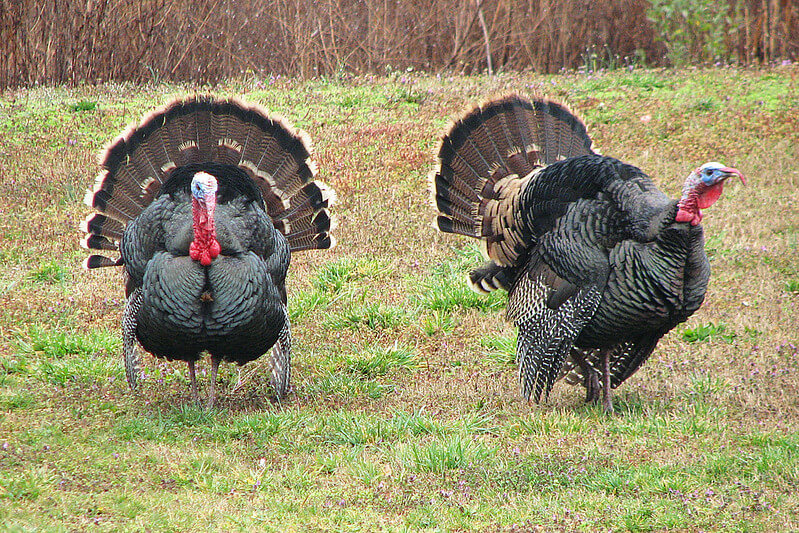“Turkey Day”…Didn’t Start That Way
By Tom Torma
Broadcast 11.23 & 11.26.2022

Photo by Vicki DeLoach, CC 2.0.
Listen:
Thanksgiving’s association with turkey is so strong that the holiday often goes by the moniker “Turkey Day.” But how, exactly, the bird came to be associated with this most American of holidays remains something of a mystery.
The wild turkey is native to 39 states, including Montana. However, the domestic turkey has its origins further to the south, in Central America, where the Aztecs first introduced the bird to European explorers. By the late 1500s the turkey was already widespread throughout Europe, where its large volume of meat made it a popular fare for Christmas celebrations.
The first American colonists faced a litany of difficulties; starvation and disease were common among settlers in the New World. Overcoming these hardships was a cause for celebration and cities from as far as San Elizario in west Texas to Frobisher Bay in northern Canada claim the mantle of first Thanksgiving in North America. However, tradition holds that the English Pilgrims hosted the first Thanksgiving during the autumn of 1621 in Plymouth, Massachusetts.
After bringing in a successful harvest, the settlers followed English custom with a harvest festival. According to Edward Winslow, one of the Plymouth settlers, the colonists went “fowling” to stock the celebration. Although there is no specific mention of turkey at this particular feast, other settlers commented on the abundance of the large bird in the area—so it is certainly a possibility.
Soon, a group of Wampanoags joined the fifty-three pilgrims, possibly attracted by the sound of the fowlers’ guns. They contributed five deer, and probably other foods such as maize bread, pumpkin, squash, and seafood. What began as a modest harvest celebration was turned into a three-day feast.
While relations between these original inhabitants and the colonists later soured, the celebration remained etched in the mind of America’s early settlers. Before 1863, when President Lincoln proclaimed it as an annual celebration, Thanksgiving had mostly been a state-level holiday, with occasional Presidential proclamations for a national celebration. Then, in 1941, Congress fixed the date to the fourth Thursday in November – the day we now celebrate.
The turkey’s role in the celebration was not always so clear. What was clear was that the turkey was North America’s only successfully domesticated barnyard animal. Alexander Hamilton and Benjamin Franklin were both reportedly fans of this large bird. Indeed, New England has included turkey in Thanksgiving celebrations since the Colonial era; however, it did not gain a national association until later. During the twentieth century, soldiers fighting in both world wars, as well as men working on nationwide New Deal projects such as the Civilian Conservation Corps, celebrated with turkey and might have carried the tradition home. But it did not become a fixed part of the holiday until 1947, when President Truman feasted on Thanksgiving turkey at the White House.
Over the years, the wild turkey did not fare so well. Throughout the 1800s, pressure from habitat loss and over-hunting caused the turkey to disappear from all but the most remote forests and habitable lands. Indeed, the turkey appeared to be at the brink of extinction. Domestic turkeys proved unable to survive in the wild, but a program of netting, trapping, and moving wild birds that began in the 1930s proved to be an enormous success. By the 60s, the bird was fully recovered.
Today, there are an estimated seven million turkeys in the wild. In Montana, wild turkeys forage for berries, seeds, and insects in ponderosa forests and grasslands as well as open agricultural lands of the state. For many Montana families, hunting these birds has become as much a part of the celebration as feasting upon them. Thanks to the conservation efforts that ended a half century ago, the turkey has become more than just a symbol of abundance to be thankful for; it is also a reminder of hardship overcome, and a symbol of hope for a brighter future.
Every week since 1991, Field Notes has inquired about Montana’s natural history. Field Notes are written by naturalists, students, and listeners about the puzzle-tree bark, eagle talons, woolly aphids, and giant puffballs of Western, Central and Southwestern Montana and aired weekly on Montana Public Radio.
Click here to read and listen to more Field Notes. Field Notes is available as a podcast! Subscribe on Apple Podcasts or wherever you listen to podcasts.
Interested in writing a Field Note? Contact Allison De Jong, Field Notes editor, at adejong [at] montananaturalist [dot] org or 406.327.0405.
Want to learn more about our programs as well as fun natural history facts and seasonal phenology? Sign up for our e-newsletter! You can also become a member and get discounts on our programs as well as free reciprocal admission to 300+ science centers in North America!












